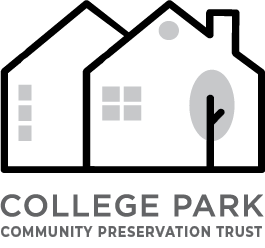How it Works
By separating ownership of the home from the land, the Community Land Trust model makes homeownership more affordable for the initial buyer while preserving long-term affordability for future owners. Continue reading to learn more!
What is a Land Trust Model?
Community land trusts (CLTs) are nonprofit, community-based organizations that hold land in trust for the long-term benefit of the community. By owning land and partnering with individuals to purchase homes on it, Community Land Trusts (CLTs) ensure that the land remains a shared asset and that housing remains permanently affordable.
While CLT-owned land can support a variety of development types—including commercial, agricultural, and mixed-use projects—most CLTs, including the College Park Community Preservation Trust, focus on maintaining long-term housing affordability in the face of rising costs and displacement.
The Three Pillars of CLT Work:
Community Control
Community Land Trusts (CLTs) are rooted in local leadership and prioritize community decision-making regarding land use and stewardship.
Stewardship & Support
CLTs provide long-term oversight, guidance, and support to homeowners, ensuring stability and success in homeownership.
Permanent Affordability
Homes in a CLT remain affordable not just for today’s buyers, but for generations to come, sustaining affordable homeownership opportunities over time.
Shared Equity Homeownership
In many American cities, rising property values have drastically increased the cost of housing, pricing out residents in both high-opportunity areas and historically underserved neighborhoods. As incomes struggle to keep pace with the soaring cost of land and housing, homeownership is becoming increasingly unattainable for everyday families. The community land trust (CLT) model offers a solution by removing land from the speculative real estate market and preserving it for community-serving purposes, most notably, permanently affordable housing.
How do CLTs work?
CLT homeowners purchase their homes at prices they can afford and are more likely to remain in their homes for the long term, without the threat of rapidly increasing housing costs or property taxes driven by market trends.
CLTs ensure permanent affordability through a shared ownership structure (shared equity). The homeowner owns the house—the physical structure—while the land beneath it is owned by the trust and stewarded for the benefit of the broader community.
Homeowners enter into a 99-year agreement with the CLT, granting them exclusive, inheritable use of the land. This agreement is renewable and designed to provide long-term stability.
Naturally, homeowners build equity in their homes over time. In a shared equity model, if a homeowner decides to sell, the CLT has the first opportunity to repurchase the home and sell it to another income-qualified buyer. This resale process maintains the home’s affordability for future generations while still allowing sellers to benefit from their investment.
By separating land ownership from homeownership, the CLT model creates a sustainable path to homeownership—one that balances individual opportunity with long-term community benefit.
Benefits of Shared Equity
Sustainable Homeownership
Shared equity significantly improves the chances of achieving and maintaining homeownership for individuals and families, particularly for those with lower incomes and from diverse racial backgrounds. By utilizing a model that leverages shared equity and public investment, the Trust makes homeownership more attainable for those who may otherwise struggle to enter the housing market.
Wealth Building
By reducing the initial purchase price through public investment, individuals and families have a better chance of building equity over time, thus narrowing the wealth gap and increasing financial stability for historically marginalized groups.
Advancing Public Investment
Efficient and strategic allocation of public investment enables the Trust to create more affordable housing opportunities and help a greater number of community members find stable and sustainable homes.
Stronger Neighborhoods
The positive effects of the Trust extend beyond individual households. As homeownership becomes more attainable, it strengthens the fabric of communities, leading to safer, higher-quality neighborhoods. Homeowners often have a vested interest in their community’s well-being, fostering a sense of pride and responsibility that promotes community bonds and neighborhood improvements.
Advancing Education and Workforce Outcomes
The correlation between stable housing, education, and job attainment is well-established. Stable home environments positively impact children’s educational performance and provide adults with a strong foundation for career advancement and economic mobility. As the Trust focuses on affordable homeownership, individuals and families gain stability and security, which can translate into improved educational outcomes and better employment prospects.
